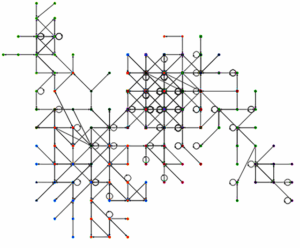Internal linking, particularly contextual link suggestions, is a powerful SEO strategy that enhances user experience and site navigation. By strategically placing relevant internal links within FAQs, glossaries, and related content, you can improve click-through rates, reduce bounce rates, and boost search engine rankings. Effective use of these suggestions signals to search engines the interconnected value of your content, optimizing site structure and fostering seamless user engagement. Measuring success through tools like Google Analytics allows for data-driven optimization, aligning with user intent and ultimately driving higher conversion rates. Learn how to leverage contextual link suggestions to maximize SEO performance and enhance user satisfaction.
In today’s digital landscape, effective internal linking is vital for enhancing user experience and boosting SEO performance. This guide explores the power of contextual links within FAQs and glossary sections. By understanding the foundation of internal linking, you can unlock its SEO potential, improve readability, and foster engagement. We’ll provide practical strategies, from defining relevant terms to implementing structured links, helping you master the art of using contextual link suggestions for optimal online visibility.
- Understanding Internal Linking: The Foundation of Contextual Links
- Unlocking SEO Potential: Why FAQs and Glossaries Need Internal Linking
- Contextual Link Suggestions: A Powerful Tool for User Experience
- Implementing Effective Internal Links in FAQ Sections
- Strategies to Enhance Readability and Engagement with Linked Glossary Terms
- Measuring Success: Analyzing the Impact of Internal Linking on SEO and User Behavior
Understanding Internal Linking: The Foundation of Contextual Links

Internal linking is a fundamental strategy in search engine optimization (SEO) that involves connecting relevant pages within your website. By using contextual links, you establish a logical flow of information and enhance user experience. These internal links act as bridges between related content, allowing both users and search engines to navigate through your site with ease. When implementing internal linking, consider the relevance and context of each link; this is where contextual link suggestions come into play.
A contextual link suggestion is a recommended internal link placed strategically within your content based on its subject matter. These suggestions aim to direct users to related pages that provide additional value. For instance, if you’re writing an article about “SEO Best Practices,” a contextual link could be a relevant blog post titled “How to Optimize Your Website for SEO.” This not only improves user engagement but also signals to search engines that your content is interconnected and valuable, contributing to better contextual link suggestions optimization. By following a tutorial on how to use these suggestions effectively, you can transform your website’s architecture into a user-friendly and search-engine-friendly labyrinth.
Unlocking SEO Potential: Why FAQs and Glossaries Need Internal Linking

In the dynamic world of search engine optimization (SEO), FAQs and glossaries serve as powerful tools to enhance user experience and boost website visibility. Unlocking their full potential requires a strategic approach, and here’s where internal linking plays a pivotal role. By integrating contextual link suggestions, these sections can become more than just repositories of information; they transform into dynamic gateways to relevant content within your site.
Contextual link suggestions tips offer a structured strategy to weave these links naturally. A tutorial on implementing this technique might guide you to identify related topics and place internal links judiciously. This not only improves crawlability but also enriches user journeys, encouraging deeper engagement. The result is a more optimized site structure that satisfies both users and search engines, ultimately driving better rankings and increased organic traffic.
Contextual Link Suggestions: A Powerful Tool for User Experience

Contextual Link Suggestions are a powerful tool that can significantly enhance user experience and search engine optimization (SEO). By understanding the context in which users interact with your content, these suggestions allow for relevant internal links to be strategically placed, ensuring a seamless navigation journey. When implementing contextual link suggestions, consider the following tips: align links with the surrounding content, maintain a natural flow, and provide additional value to readers by connecting them to related resources.
This SEO strategy optimizes website architecture by guiding users and search engines alike to relevant pages. By integrating contextual link suggestions, you can improve click-through rates, reduce bounce rates, and foster better information retrieval, ultimately contributing to higher rankings in search engine results. Remember, the key is to create a harmonious blend of internal links that enrich user experience without appearing forced or disruptive.
Implementing Effective Internal Links in FAQ Sections

Implementing effective internal links within FAQ sections can significantly enhance user experience and search engine optimization (SEO). By strategically placing contextual link suggestions throughout your FAQs, users can navigate relevant content easily, fostering a more engaging and informative interaction. This approach not only improves site usability but also signals to search engines that your content is interconnected and valuable.
When utilizing contextual link suggestions, focus on creating links that naturally fit within the FAQ’s context. These should be relevant, providing users with additional insights or related information without disrupting the flow of the question-and-answer format. A well-executed internal linking strategy in FAQs can lead to better rankings in search results and ultimately contribute to improved conversion rates through enhanced user satisfaction.
Strategies to Enhance Readability and Engagement with Linked Glossary Terms

To enhance readability and engagement with linked glossary terms, consider leveraging contextual link suggestions as a powerful strategy. These suggestions provide seamless integration of relevant definitions directly within the text, guiding readers effortlessly through complex topics. By strategically placing these links, you create a user-friendly experience that encourages deeper exploration. For instance, when explaining an intricate concept, a contextual link to its definition can be woven naturally into the sentence, allowing readers to grasp the term’s meaning without interrupting their flow.
Contextual link suggestions optimization involves aligning these links with the surrounding content’s context and purpose. A tutorial on implementing this feature could include best practices such as using descriptive anchor text that accurately represents the linked term’s definition. This approach not only aids in understanding but also improves SEO efforts by signaling to search engines the comprehensive nature of your content, fostering better ranking potential for both the glossary section and the broader article.
Measuring Success: Analyzing the Impact of Internal Linking on SEO and User Behavior

Measuring the success of internal linking is key to understanding its impact on SEO and user behavior. By analyzing where users click and how they navigate through your site, you can gauge which contextual link suggestions are most effective. Tools like Google Analytics and Search Console provide valuable insights into click-through rates (CTRs), time spent on pages, and bounce rates. These metrics help identify high-performing links that drive engagement and optimize low-performing ones.
Contextual link suggestions optimization should be guided by user intent. By understanding the context in which users are clicking, you can ensure links align with their information needs. This strategic approach, supported by contextual link suggestions tips and a well-defined strategy, not only improves SEO rankings but also enhances the overall user experience, encouraging longer sessions and higher conversion rates.
